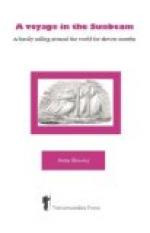Sunday, February 4th.—It was blowing hard all day, raining, snowing, and sleeting. The scenery appeared to be pretty, and we passed through crowds of picturesque junks.
At 4.25 we rounded Tomamgai Smia, and at 9 p.m. anchored off the town of Kobe, or Hiogo.
These constant changes of names are very puzzling. Miaco and Yeddo, which we did know something about, are quite cut out, and replaced by Kioto and Tokio. Oddly enough, the same syllables, reversed, mean capital of the Western Empire and capital of the Eastern Empire respectively.
Monday, February 5th.—By seven o’clock a boat was alongside with letters from the Consul and Sir Harry Parkes, who had kindly made all the necessary arrangements for us to see the opening of the railway from Kobe to Kioto, and for the presentation of the gentlemen to the Mikado.
It certainly was a great opportunity for seeing a Japanese holiday crowd, all dressed in their best. Thousands and thousands of people were in the streets, who, though naturally anxious to see as much as possible, behaved in the most quiet and orderly manner. The station was beautifully decorated with evergreens, camellias, and red berries. Outside there was a most marvellous pavilion, the woodwork of which had been entirely covered with evergreens, and ornamented with life-size dragons and phoenixes (the imperial insignia of Japan), all made in flowers. The roof was studded with large chrysanthemums—the private device of the Mikado, that of the Tycoon being three hollyhock leaves. The sides of the pavilion were quite open, the roof being simply supported on pillars; so that we could see everything that went on, both inside and out. The floor was covered with red cloth; the dais with an extremely ugly Brussels carpet, with a large pattern. On this the Mikado’s throne was placed, with a second canopy above it. Tom in R.N.R. uniform, the other gentlemen in evening dress, accompanied the Consul on to the platform to receive the Mikado; while the children and I went with Mrs. Annesley to seats reserved for the foreign representatives. There were not many Europeans present; but the platform was densely crowded with Japanese, sitting on their heels, and patiently waiting to see the extraordinary sight of their hitherto invisible spiritual Emperor brought to them by a steam engine on an iron road. The men had all had their heads fresh shaven, and their funny little pigtails rearranged for the occasion. The women’s hair was elaborately and stiffly done up with light tortoiseshell combs and a large pin, and decorated with artificial flowers. Some of the children were gaily dressed in red and gold under garments, the prevailing colour of the costumes being dark blue, turned up with red. They also wore gay embroidered obis, or large sashes, which are put on in a peculiar fashion. They are of great width, and are fastened tightly round the waist, while an enormous bow behind reaches




